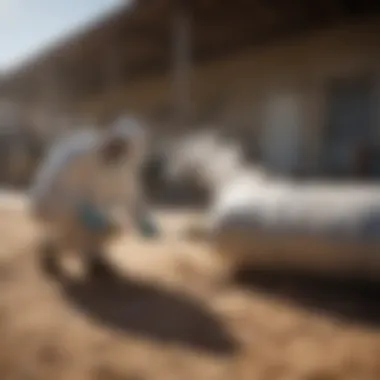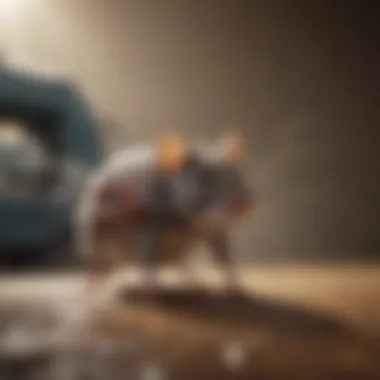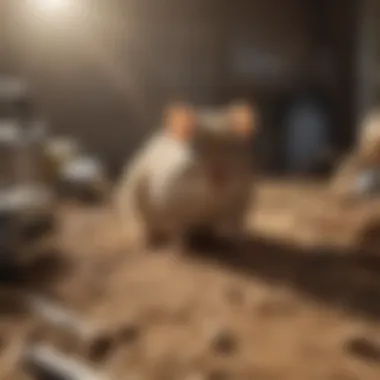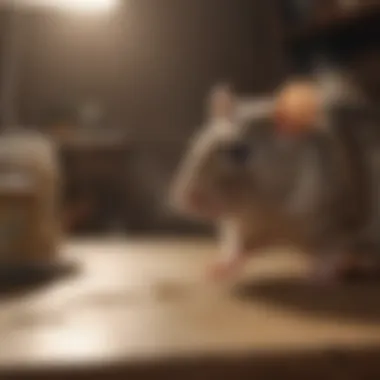Fumigation for Rodents: Strategies and Considerations


Intro
Rodent infestations can turn a cozy home into a battleground. Understanding how to prevent these six-legged and fur-covered intruders is vital. This exploration does not just scratch the surface but digs deep into the practical strategies you can employ to ensure your home stays pest-free.
Let's embark on this journey of prevention, ensuring you have the tools and knowledge to face potential rodent problems head-on.
Understanding Rodent Infestations
Rodent infestations are not merely an inconvenience; they pose a serious threat to households and properties alike. Understanding the nuances of these infestations is essential for creating effective strategies that can mitigate their impact. When one grasps the signs, types, and repercussions of rodent invasions, they can better strategize fumigation and other control methods, which leads to more successful outcomes.
Types of Rodents
In the world of pests, not all rodents are created equal. Knowing which species of rodents are wreaking havoc can be pivotal in choosing the right elimination strategy. Common culprits include:
- Norway Rat: Often found in basements and sewers, these rats are larger and more aggressive compared to others.
- Roof Rat: Known for their slender bodies, they favor attics and trees, making them more visually elusive.
- House Mouse: A small, agile pest that can squeeze through tiny gaps, making homes particularly vulnerable.
- Field Mouse: Preferring outdoors, they can enter homes during certain seasons in search for food.
Each species has its distinct behavior and habits, impacting everything from baiting techniques to fumigation strategies. Understanding these types allows for tailored approaches that can effectively manage rodent populations.
Signs of Infestation
Recognizing the early signs of a rodent infestation can save homeowners from costly repairs and health risks. Common indicators include:
- Droppings: Small, black pellets usually found near food sources or nesting areas.
- Gnaw Marks: Rodents have ever-growing teeth, so they chew on wood, wires, and even plastic.
- Nesting Material: Use of shredded paper, fabric, or other soft materials to construct nests often found in hidden areas.
- Footprints: Dusty or dirty areas may reveal small paw prints or smudge marks.
Spotting these signs early empowers homeowners to take action before an infestation spirals out of control.
Impact of Rodents on Health and Property
Rodents are not just a nuisance; they can significantly affect both health and property. Their droppings, urine, and fur are potential carriers of diseases such as hantavirus, leptospirosis, and salmonella. Notably, the risks extend beyond just the physical health of residents. The structural damage inflicted by gnawing rodents can jeopardize the integrity of a home, leading to costly repair bills.
"Rodents can compromise not only the safety of your home but also the wellbeing of those who inhabit it."
From contaminated food supplies to the potential destruction of insulation and electrical wiring, the consequences of rodent infestations are substantial. Homeowners must not only act swiftly upon noticing signs of these infestations but also recognize the importance of thorough monitoring and preventive measures.
In summary, a comprehensive understanding of rodent infestations sets the stage for effective management. By identifying rodent types, recognizing infestation signs, and acknowledging the broader impact on health and property, homeowners can take proactive steps to protect their living space.
Prolusion to Fumigation
Fumigation stands as a cornerstone in pest management, particularly when dealing with the often insidious problem of rodent infestations. This method is not merely about setting traps or scattering poison. Instead, it encompasses a systematic approach that ensures thorough eradication of these unwanted guests from your living space.
Why is this important? Rodents, while small, can wreak havoc on a property. They can chew through insulation, wiring, and even structural elements of a house. Consequently, fumigation serves a dual purpose: it’s about health and property protection. By understanding the context and methodology of fumigation, homeowners can make informed decisions that prioritize their wellbeing and investment.
Definition and Purpose
Fumigation is a pest control technique that uses gaseous substances to eliminate pests. Simply put, this process involves filling a space with toxic gas that reaches every nook and cranny, effectively suffocating and killing rodents. The purpose is not just to address the existing problem but to prevent future infestations. It’s like applying a protective sealant that manages any lurking threats in hidden corners of your home.
Moreover, this method is particularly beneficial in cases where other options may fall flat. For example, standard traps might not catch all the rodents or even worse; it’s possible for the problem to go unnoticed until significant damage has occurred.
Historical Context
Fumigation isn’t a modern tactic invented in response to today's pest issues. In fact, it has roots stretching back hundreds of years. Historically, various cultures utilized smoke and chemical agents for pest control. The ancient Egyptians, for instance, used sulfur to combat rats and mice within their storage areas. Fast forward to the late 19th century, and you find more sophisticated methods being developed as cities grew and sanitation became a critical issue.


It wasn’t until the 20th century that chemical innovation really kicked off. The introduction of broad-spectrum pesticides transformed fumigation from a rudimentary practice into a full-blown science. France was one of the first countries to embrace this advancement, leading to safer and more effective solutions. Today, we recognize fumigation as a crucial component of integrated pest management strategies, underscoring its enduring relevance.
"Fumigation is not just a method; it's a strategy grounded in history and scientific advancement that effectively combats rodent fears and pestilence."
So, as we delve deeper into the specifics, it’s essential to appreciate the depth and significance of fumigation. Each step taken in the process is a culmination of centuries of understanding and innovation, designed to ensure a safer, rodent-free environment.
The Science of Fumigation
Understanding the science behind fumigation is crucial for anyone tackling a rodent issue. This knowledge guides not just the application of fumigants but also helps in assessing their effectiveness and safety. Fumigation operates on scientific principles that maximize the chances of eliminating these pesky intruders. When armed with the right information, homeowners can deploy strategies that safeguard their spaces effectively while ensuring environmental safety.
Fumigants: Types and Composition
Fumigants are the chemicals specifically designed to target pests like rodents. It's like sending in a specialized task force to tackle an infestation. Various types of fumigants exist, each with unique compositions.
- Phosphine: A commonly used gas that works well in confined areas like grain storage. It's effective but requires careful handling due to its toxicity.
- Methyl Bromide: Historically popular, it’s being phased out in many places due to its environmental impact.
- Sulfuryl Fluoride: Ideal for structural fumigation, this compound is widely regarded for its efficacy against rodents. It penetrates wood and other materials effectively, ensuring pests hidden within are also targeted.
Understanding these types can assist homeowners in selecting the most suitable option based on their specific situation.
Mechanisms of Action
Fumigants operate by disrupting the normal physiological functions of pests, leading to their demise. When introducing these chemicals into an environment, they vaporize and permeate every nook and cranny, reaching areas that conventional methods might miss. This ability to penetrate is what makes fumigation a robust pest control approach.
- Respiratory Disruption: Many fumigants target the respiratory systems of rodents, essentially suffocating them. This is particularly effective in closed or semi-closed spaces.
- Metabolic Interruption: Some chemicals interfere with the metabolic pathways of the pests, causing them to fail to process nutrients effectively, resulting in death.
This dual-action nature makes fumigants a formidable foe against rodent populations.
Factors Influencing Fumigation Efficacy
The success of fumigation doesn’t solely depend on the product used; several factors play a significant role in determining its effectiveness.
- Concentration of Fumigants: The right amount of fumigant is crucial. Too little might not yield results, while too much could pose health risks.
- Duration of Exposure: The length of time the space is exposed to the fumigant matters. Adequate exposure ensures that all life stages of rodents, from juvenile to adult, are affected.
- Environmental Conditions: Temperature and humidity levels can affect how well fumigants work. Higher temperatures can enhance the evaporation of the fumigant, while the right humidity helps maintain effective concentrations within the treated environment.
Each of these elements must be carefully considered to optimize the fumigation process.
"Fumigation is not just a matter of applying chemicals; it requires a nuanced understanding of pest behavior, environmental conditions, and chemical interactions."
Arming oneself with this knowledge ensures that the fumigation process is both effective and responsible, paving the way for a rodent-free environment.
Fumigation Process for Rodents
Fumigation serves as a critical step in addressing rodent infestations, pinpointing both a targeted and potent strategy for eradication. This process doesn't merely rely on the toxic nature of the substances used; it also encompasses a well-structured sequence of events that ensures a thorough, effective approach. Understanding this process builds a foundation for homeowners and pest control professionals looking to reclaim their spaces from unwanted pests. Key elements of this procedure include expert inspection, property preparation, correct application of fumigants, and diligent follow-ups after treatment.
Pre-Fumigation Inspection
Before initiating any fumigation efforts, a meticulous inspection is paramount. This step involves a thorough walkthrough of the premises to identify specific rodent hotspots. The inspector typically looks for rodent droppings, gnaw marks, burrows, and tracks. A complete assessment guarantees that the fumigation targets the right areas where rodents are most active.
- Assessment of Entry Points: Identifying how rodents gain access to the space helps in sealing those spots during preparation.
- Damage Analysis: Documenting what damage has already occurred can assist in evaluating the effectiveness of the fumigation later.
The inspector's notes form a blueprint that guides the entire fumigation endeavor. Not only does this ensure a focused application of resources, but it also allows for a proactive stance in preventing future infestations.
Preparation and Sealing
Once the inspection is done, preparation kicks in. This phase is vital and involves several steps to create a sealed environment necessary for effective fumigation.


- Clear the Area: Homeowners should remove food, pets, and other items from the treatment zones. Anything that can absorb the fumigant or be harmed by it needs to be out of the way.
- Sealing the Premises: Windows, doors, and ventilation must be adequately sealed. This closing off of the spaces reduces the likelihood of the fumigant escaping and ensures that it concentrates effectively where needed.
Paying attention to this step often determines the success of the treatment. Any gaps left behind can result in diminished effectiveness, allowing some rodents to escape or survive.
Application of Fumigants
With the area prepared, it's time to apply the fumigants. Following the chemical manufacturer’s guidelines ensures safety and efficacy in the process. Here are some general factors to consider:
- Fumigant Selection: Different fumigants are tailored for various pest scenarios. Using an appropriate one is critical for tackling rodents.
- Distribution Technique: Fumigants can be introduced through foggers or injected directly into the structure. The even spread across the entire area increases the likelihood of reaching pests hidden in nooks and crannies.
It's crucial that during this phase, precautions are rigorously followed. This includes ensuring that all human and pet occupants are not inside the premises until the process concludes.
Post-Fumigation Monitoring
After the fumigation is complete, monitoring comes into play. Residents may be eager to return to their usual routines, but patience is vital in this phase. Here’s what is generally involved:
- Ventilating the Space: After treatment, it’s crucial to air out the space. Proper ventilation allows any residual fumigant to disperse safely.
- Monitoring for Activity: Homeowners should look for signs of rodent activity to ensure the fumigation was successful. This monitoring can extend for weeks, checking for new droppings or sounds indicating return of the pests.
Finally, keeping records of the treatment and any signs of re-infestation can guide future pest control strategies.
"The effectiveness of a rodent fumigation process relies heavily on thorough preparation, careful application, and vigilant monitoring. Each step intertwines to form a robust defense against re-infestation."
In summary, the fumigation process for rodents entails meticulous planning and execution. A blend of inspection, preparation, application, and monitoring brings homeowners a step closer to a rodent-free environment.
Health and Safety Considerations
When it comes to managing rodent infestations through fumigation, the focus shouldn't solely rest on effectiveness. The realm of health and safety should be regarded with equal, if not greater, importance. This section elucidates the potential risks involved with fumigants, outlines essential protective measures for humans and pets, and scrutinizes the environmental impact of these scientific solutions.
Risks Associated with Fumigants
Fumigants may be effective, but they come with a slew of risks that must not be overlooked. These chemicals, while serving their purpose in eliminating pests, can pose dangers to human health. Commonly used fumigants like methyl bromide or phosphine have been linked to serious health issues, ranging from headaches and dizziness to more severe respiratory complications.
Additionally, exposure can likely occur during mishandling or improper application of these chemicals; it’s not just rodents that these substances can harm.
Households should be especially cautious; children and elderly individuals might be more susceptible to these effects. To mitigate these risks, adherence to guidelines and regulations surrounding the use of such chemicals is non-negotiable. Always consider this:
"Safety first, whether it's dealing with pests or managing your household."
Protective Measures for Humans and Pets
In light of these risks, taking proactive steps to safeguard yourself and your pets is crucial. Here are some essential protective measures:
- Evacuation: Before any fumigation process begins, it is vital for all inhabitants, including pets, to vacate the premises. The residence should remain closed for the duration of the treatment.
- Ventilation Post-Treatment: After fumigation, allow ample time for the space to ventilate completely. Airing out the treated area will help remove any residual chemicals that might linger.
- Professional Assistance: Always consider hiring trained professionals who understand the intricacies of handling these materials safely. Their expertise can greatly reduce risks associated with improper use or accidental exposure.
These practices serve not just as precautionary measures but as essential actions that promote a safer environment during and after the fumigation process.
Environmental Impact
The use of fumigants doesn't only raise red flags for human and pet safety; the environment bears its share of the burden as well. Many fumigants are known to have negative effects on wildlife and ecosystems. For instance, gases that seep into the soil can harm beneficial insects and microorganisms. Moreover, fumigants can potentially contaminate water sources, impacting aquatic life.
As awareness grows regarding these impacts, some companies have begun experimenting with less toxic alternatives that are both effective for rodent control and more environmentally friendly. While these alternatives may not yet yield the same levels of efficacy as traditional fumigants, they do represent a promising direction in pest management that aligns with modern ecological values.
In summary, addressing the health and safety considerations linked to rodent fumigation is crucial. Recognizing the risks posed by fumigants, implementing protective strategies for your household, and remaining vigilant about environmental impacts can lead to a safer, more responsible approach to pest control. By keeping safety at the forefront, both humans and nature can coexist harmoniously, even in the face of rodent challenges.


Professional vs. DIY Fumigation
Deciding between professional and DIY approaches for rodent fumigation is a critical juncture many homeowners face. The intricacies involved in effectively managing rodent populations can be daunting, especially given the varying degrees of infestation and the unique characteristics of different environments. Here, we'll delve into the specific elements to consider, along with the benefits and potential pitfalls of both strategies.
When to Seek Professional Help
Choosing to call in an expert is often dictated by the severity and nature of the rodent infestation. If you’re dealing with a small issue, such as a couple of mice scurrying across the floor, it might seem manageable at first. However, before you roll up your sleeves, ask yourself:
- Is there evidence of extensive nesting or frequent droppings? If so, this could indicate a larger colony that may require targeted treatment that a professional can provide.
- Are you uncertain about the type of rodent? Identifying the species helps determine the appropriate materials and methods for fumigation. Professionals have the training to quickly and accurately assess the situation.
- Do you have the right materials and safety equipment? Many fumigants require special handling and personal protective equipment that might be outside the reach of the average homeowner.
In situations where you answer 'yes' to any of these questions, it’s best to place a call to a pest control expert. They bring specialized equipment, a wealth of experience, and knowledge about local regulations that you might not be aware of.
Remember: Effective rodent management is not just about eradication, it also involves understanding the underlying issues that lead to infestations—something professionals can address thoroughly.
Understanding DIY Risks
Opting for a DIY approach can seem appealing due to cost savings, but it comes with its own bundle of risks. Here are several factors to keep in mind:
- Improper Handling of Chemicals: Many fumigants are toxic and can pose significant health risks if mismanaged. A misstep in mixed ratios or application methods could not only diminish the effectiveness but also create exposure concerns for your family and pets.
- Inadequate Coverage: DIY methods often fall short of ensuring complete coverage in the areas where rodents nest or frequent. It can be especially hard to reach secluded areas without professional equipment.
- Misdiagnosing the Problem: Many times homeowners misinterpret the signs of an infestation. What appears to be a minor nuisance could actually be a symptom of a much larger problem, requiring tailored intervention that only professionals may provide.
- Time and Effort: The process can be labor-intensive. Setting aside time for thorough inspection and treatment isn't always feasible, especially for busy house owners who already juggle numerous responsibilities.
For those who prefer a hands-on approach, it’s crucial to equip yourself with detailed knowledge about the specific fumigants and methods.
Post-Fumigation Strategies
After the intense measures of fumigation, the work isn’t entirely over. It’s like finally finishing a marathon only to find out you still have a few laps around the track to complete. Post-fumigation strategies are essential in ensuring that the effectiveness of the treatment is maximized, and the chances of future rodent infestations are minimized. Addressing necessary control measures and adopting preventative practices is crucial for warding off any unwelcome guests in your home, especially after having gone through the hassle and expense of fumigation.
Control Measures After Treatment
Once the fumigation process is wrapped up and the area is declared safe for re-entry, it’s time to get serious about control measures. This involves not only assessing the effectiveness of the fumigation but also strategizing how to keep the rodents away for good. Here are some critical steps to consider:
- Conduct Inspections: Right after returning, carry out a detailed inspection of the treated areas. Look for any signs that indicate rodents have ventured back. Droppings, gnaw marks, and nests are telltale signs that the problem might not be entirely solved.
- Repair Entry Points: Rodents are crafty, and they can squeeze through surprisingly small gaps. Seal up any holes, cracks, or gaps in walls, foundations, and around pipes.
- Clean Thoroughly: The urgency of cleanliness can't be overstated. Any remaining food particles, open trash, or clutter can invite rodents right back into your home. Clear out anything that might give them a free meal.
- Set Traps: While fumigation might reduce the rodent population, it may not eliminate all of them. Consider placing non-lethal traps in strategic locations to catch any stragglers.
These control measures play a pivotal role in solidifying the results of fumigation and keeping your home rodent-free.
Preventative Practices
Preventing future infestations is just as vital as the treatment itself. Implementing a combination of habits can significantly reduce the risk of rodents making a comeback. Here’s what homeowners can proactively do:
- Maintain Landscaping: Trim back any overgrown bushes and trees that may serve as attractive nesting sites. Keeping lawns and gardens tidy reduces their opportunities to settle close to your home.
- Food Storage: Store food in airtight containers. This applies not just to your kitchen, but also pet food and birdseed. Rodents have a keen sense of smell and will be drawn in by accessible food.
- Regular Check-Ups: Make it a habit to inspect your property for signs of wear and tear. Repair frames and close up gaps before they become entry points for rodents.
- Educate Family Members: A well-informed household is a key defense against rodents. Ensure everyone in the family knows what signs to look for and how to maintain cleanliness.
- Professional Maintenance: Consider regular pest control check-ups to keep infestations at bay. Pest control services can offer preventative treatments, which may provide an additional layer of security against future incursions.
"An ounce of prevention is worth a pound of cure."
Employing these preventative practices not only safeguards your home from being a rodent haven but also cultivates a comfortable living space for you and your family. With these strategies, you can enjoy peace of mind, knowing you’ve done your part to keep unwanted visitors at bay.
Culmination and Future Directions
In closing this exploration of fumigation as a method for controlling rodent infestations, it's important to underline the significance of having a well-rounded perspective on both the practical and theoretical aspects. Fumigation stands out as a powerful tool, but its effectiveness hinges on a thorough understanding of the entire process— from initial problem identification to the implementation of strategies that prevent future infestations.
While many homeowners may feel tempted to tackle rodent issues on their own, this article has shown that understanding fumigation protocols could potentially mean the difference between a one-time fix and a recurring problem.
Summary of Key Points
- Rodent Infestation Signs: Being diligent in identifying the signs of rodent presence can allow for timely action.
- Fumigation Process: Knowing the step-by-step process involved in fumigation helps ensure thorough treatment and prevents omitted details.
- Health and Safety Considerations: Understanding the risks associated with fumigants highlights the need for proper safety measures, ensuring both human and environmental health.
- Professional Assistance vs DIY: Knowing when to consult with professionals can save time and money, ensuring that the problem is handled effectively.
- Post-Fumigation Practices: Following up with preventative measures is crucial to avoid future infestations, reinforcing a secure environment.
Emerging Trends in Rodent Control
As we look to the future of rodent control, it is noteworthy that advancements in technology and pest management are on the rise. The field is undergoing transformation with several emerging trends:
- Use of Smart Traps: Modern traps equipped with technology are increasingly allowing for better monitoring and reporting of rodent activity.
- Eco-Friendly Fumigation Options: The push for environmentally safe fumigants is gaining traction. More companies are turning to biodegradable and less harmful chemicals.
- Data-Driven Pest Management: Utilizing data analytics and IoT can provide insights into rodent behavior and effective control measures.
- Education and Awareness: There's a growing importance placed on educating homeowners about prevention, pushing for community initiatives that empower individuals to take proactive steps.



